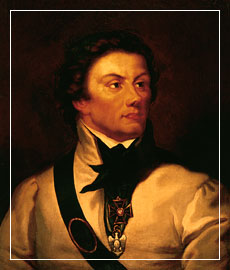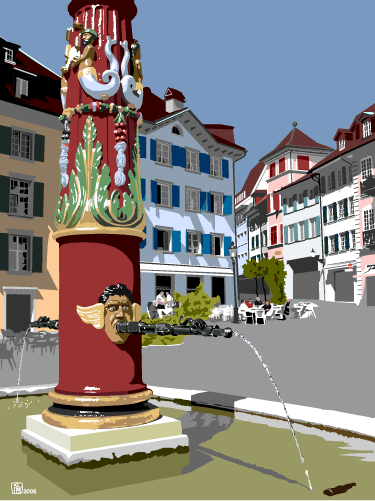Captivity and return to America
Origin and youth
Kosciuszko was born in 1746 in a family from the szlachta (nobility) in Mereczowszczyzna, next to Kossowo, 100 km east of today's eastern Polish border. This poor area, formerly Podlasie, is now part of the Republic of Belarus. His father wanted him to have a solid education and sent him to the Piarist College in Lubieszow, southwest of Pinsk.
Before Kosciuszko finished the school, his widowed mother moved to Siechnowicz, approximately 6 km to the west from Brest – today's border town.
Kosciuszko later became the administrator of the family estate comprising a community of 300 people, but his lively personality and character did not agree with the peaceful life of a nobleman. Five years later, he took on a career as an army officer.
Between 1765-69 he attended the Corps of Cadets (Korpus Kadetow) in Warsaw, where he received at the end a royal scholarship for a study stay in France. Here he acquired between 1769-74 his expertise as a military engineer in building military fortifications. So Kosciuszko was abroad during the First Partition of Poland in 1772.
America
In 1774, he returned to Poland. Because of disagreements with his brother and because of an unfulfilled love, Kosciuszko went back to France in 1776. From there he moved to America to participate as a voluntary in the War of Independence of the United States against England. The United States Congress named him a colonel of engineers in the United States Army.
Kosciuszko built eight fortifications for the protection of New York and Philadelphia, contributing this way clearly to the victory over England. At the end he participated personally in the battle at the southern front. For his merits, he was promoted to Brigadier-General by President George Washington and obtained beautiful estates near to Westpoint and an annuity. Kosciuszko didn't stay in America, but returned in 1784 to Siechnowicz, where his brother had sold all their possessions. Despite implementing new methods of management that Kosciuszko brought from the United States, his estate was no longer profitable and he began going into debt.
The Leader
It is during the second (1792) and third (1795) partitions of Poland that Kosciuszko earned his fame as a celebrated Polish national hero.
The King of Poland - Stanislaw August Poniatowski, whose secretary was Maurice Glayre, a Swiss from the canton of Waadt, wanted to turn Poland into a modern state. Inspired by the experience of the American and French revolutions, he tried to implement similar reforms in Poland.
Internal opponents mobilized, formed the Targowica Confederation on May 14, 1792, and called on Russia for assistance. Four days later, two Russian armies crossed the Polish border. An emerging Polish army managed to delay their offensive but could not stop it. It is in mid-July, at the Battle of Dubienka on the Bug, that Kosciuszko displayed his greatness for the first time. Still, he could not prevent the Russians from crossing the river. In the meantime, the king ordered the fight to cease and joined the Targowica himself. Kosciuszko, who had not suffered a single defeat to the enemy, could not accept this and, along with other army commanders, resigned in indignation. After passing his estate of Siechnowicze to his sister and her husband, Kosciuszko emigrated. He first went to Saxony, then to France, where the Legislative Assembly gave him an honorary citizenship. Russia and Prussia then effected the 2nd partition of Poland. Prussia took Wielkopolska with Poznan, Russia took Belarus with Minsk and western Ukraine. Poland, still a large state, was now under the control of the invading Russian army.
Supporters of the reforms did not give up. From Saxony, they started preparing for the uprising. In September 1793, in Leipzig, they asked Kosciuszko to become their Supreme Commander which he accepted immediately. Through his emissaries, he was involved in the preparation of the revolution in various parts of Poland and went secretly to Krakow.
On March 24, 1794, soldiers, city dwellers and peasants from the area assembled on the Krakow Market Square for the reading of the «Uprising Act» that announced the fight for the liberation of Poland. First Kosciuszko, followed by all those assembled, made a solemn oath. The «Uprising Act» was sent across the country. Within a week, a 4000-men strong squad was formed and trained, joined by 2000 legendary Scythians (peasants armed with scythes). With all their bravery, they could not do much against the artillery and cavalry of the enemy. With this small unit, Kosciuszko set off on April 1, 1794, for Warsaw. Meanwhile, the Russians sent a small 6000-strong army to Krakow. On April 4, there was a clash near Raclawice, about 25 km north of Krakow, where Kosciuszko was victorious.
This first success triggered enthusiasm and ignited uprisings throughout Poland. On April 16, Warsaw revolted and after bloody street fighting the residents drove the Russian garrison out. Inspired by this victory, Lithuania also fought back and on 22 April, Russians had to withdraw there too.
In early May, in Polaniec, on the upper reaches of the Vistula River, Kosciuszko appointed a National Supreme Council as the new government that started operating on May 28, in Warsaw. It was also there that he made his famous «Proclamation of Polaniec».
Opponents did not stay idle. A new 9000-strong Russian army and a Prussian army of 17500 soldiers entered the country. Kosciuszko’s army numbered 14500 but he could not stop the hostile armies from joining forces. On June 9, he lost the battle at Szczekocin, 70 km north of Krakow. He retreated to Kielce and collected a new 30'000-strong army. Prussians occupied Krakow on June 14, but the main target of the invaders was to capture Warsaw. Kosciuszko arrived there on July 10, and immediately began to fortify the city with the help of the entire population. Although there were over 36000 people, trained soldiers numbered only 17000. On July 13, the siege of Warsaw by 25000 Prussians and 16000 Russians began under the personal command of Prussian King Frederick William II. The effective fortifications and the successful defense of the city led by Kosciuszko pushed back the aggressors who abandoned further attacks and left Warsaw.
Meanwhile, he mobilized some 100'000 men, assigned to various army units. They managed to beat the Prussians many times in Wielkopolska.
The Tsaritsa then sent Suvorov, her most capable general, to Poland with another 18000 men. Kosciuszko, to stop the two Russian armies from merging, gathered in the greatest hurry a small, 8.5 thousand strong troop, which struck on October 10, 1794, near Maciejowice, about 100 km south of Warsaw, the twice as numerous Russian army of Fersen. There bloody battle resulted in Kosciuszko, heavily wounded, being captured by the Russians.
Transported on windy roads, he finally arrived in St. Petersburg on December 10.
In the meantime, Suvorov occupied Warsaw on November 5 and allowed a terrible bloodshed in which Russian troops massacred 20'000 residents. Polish resistance was broken.
On January 3, 1795, the three invaders shared the country between themselves: Russia received the remainder of the Grand Duchy of Lithuania, from Courland to Volhynia, Prussia got Warsaw and Mazovia. Austria, having contributed little to the battles, took Malopolska and Krakow.
Captivity and return to America
Kosciuszko was imprisoned along with other hostages in the fortress of Petropavlovsk. The Tsaritsa sent him her personal doctor, an Englishman, who took great care of him.
In November 1795, Kosciuszko was allowed to stay in a private apartment in St. Petersburg. A year later, Tsaritsa Catherine died and her son and successor, Tsar Paul I, gave Kosciuszko his freedom, offering him land and money. Kosciuszko asked for the Poles held in Russia to be released, which he also obtained. Having received money and gear for a trip to America, he left Russia on December 19, 1796. Through Sweden and England, where he was welcomed with respect and admiration, he arrived in Philadelphia in mid-August 1797. He was also greeted there with the highest honors. This time would only stay for 9 months in the New World. On the news of the formation of Polish Legions in Italy, Kosciuszko wrote a will in 1798 for his money to be used to buy back the freedom of black slaves and to organize schools for them. He asked Jefferson to execute his will. This met many difficulties and his wishes remained mostly unfulfilled. On May 5, 1798, Kosciuszko boarded a boat to Bayonne, France.
Kosciuszko and Solothurn
The hopes Kosciuszko placed on France did not materialize. Despite receiving numerous honors and quickly entering the leading political and cultural circles of Paris, his main objective, the liberation of Poland by the Polish forces fighting alongside the French Legions in Italy and along the Rhine, did not agree with the plans of Bonaparte. Created under the French protectorate, the Duchy of Warsaw that covered Wielko and Malopolska, was linked by a personal union with the Kingdom of Saxony.
Disillusioned, Kosciuszko withdrew from public life. In Parisian salons, he met Peter Joseph Zeltner, a Swiss Member of Parliament from Solothurn. Zeltner and his family had lived in Paris since 1801 and later in the castle of Berville near Fontainebleau that he had acquired. After the collapse of the Swiss state (Helvetic Republic) that had been created by the French, Zeltner worked as a banker. Kosciuszko, on the invitation of Zeltner, lived in his home and gave lessons to his daughter Emilia as her tutor. The fall of the Napoleonic Empire put Zeltner's bank into great difficulties. Thanks to Kosciuszko’s intervention, Zeltner received in compensation a large fortune in Lithuania.
The remaining prospects of Kosciuzko for Poland to regain its independence evaporated. During a meeting in Paris, Tsar Alexander promised Kosciuszko his support but at the Vienna Congress he could not overcome the obstacles of Prussia and Austria.
The treaty signed in Vienna by the three occupying powers gave Wielkopolska to Prussia, and the former Grand Duchy of Lithuania to Russia. The “Polish Principality” was also created, the so-called “Congress Kingdom” that included Malopolska with Warsaw and that was linked by a personal union with Russia. Only Krakow enjoyed 30 years of independence until it became part of Austria.
The Tsar wished Kosciuszko's return to Poland to provide legitimacy to the new arrangement. Kosciuszko went to meet him in Braunau on the Inn. During a conversation that lasted only 15 minutes, Kosciuszko's request to join Lithuania to Poland was rejected. After this disappointment, Kosciuszko decided to settle in Switzerland. Having accepted the proposal of Francis Xavier Zeltner, brother of Peter Zeltner, he agreed to settle there. Kosciuszko arrived in early October 1815 and moved into a small apartment in the Zeltner home by Gurzelngasse, the current location of the Kosciuszko Museum.
On October 15, 1817, Kosciuszko died, most likely from the consequences of a flu.

